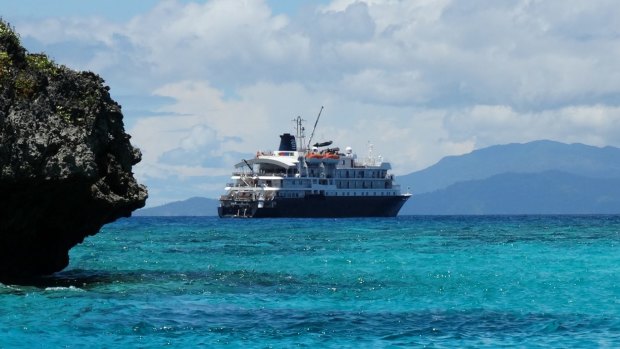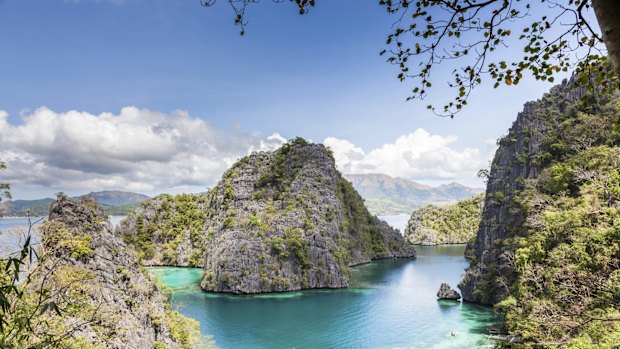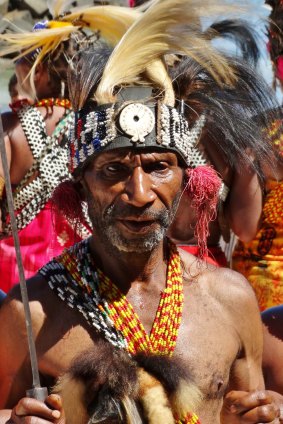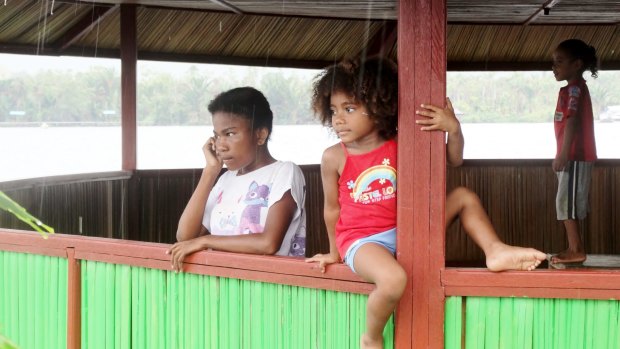This was published 9 years ago
MS Caledonian Sky expedition cruise review in south-east Asia: Beauty and surprise
To embrace the expedition cruise you must expect the unexpected and go with the flow, writes Keith Austin.
By Keith Austin

Luxury base: the Caledonian Sky, after a morning snorkelling among the atolls and coves of Pulau Wayag in West Papua.Credit: Keith Austin
Expect the unexpected, they said. There's a limit to this frame of mind, of course. Take it literally and you'll jump in the Zodiac for a day's snorkelling equipped with an umbrella, a parachute and a box of matches.
But it was going to be a beach landing, some snorkelling and then a return from the beach to the ship; footwear seemed as useful as a parachute so I didn't take any. Who knew we would end up picking our way along a jungle path in search of an abandoned WWII landing craft?
Should have expected it, really.

What a dive: Coron, in the Philippines, is popular with divers because of the World War II wrecks.
Expedition cruising, it seems, is full of this stuff. "Expect the unexpected" became a mantra throughout our 18-day cruise from the Philippines to Malaysia, Indonesia and Papua New Guinea.
During that time we got forced away from parts of Malaysia because of the threat of kidnap, snorkelled on reefs where few people, if any, had been before, explored an eight-kilometre long underground river system, swam in a lake of non-stinging jellyfish, explored World War II caves where thousands of Japanese soldiers burned to death under Allied bombardment, and looked on in shock at markets where live dogs watched recently dead companions blowtorched to rid them of their pesky fur so they could be sold for dinner.
Every day brought with it something new, something unexpected, and every evening one of the expedition team's nine experts – naturalists, historians, oceanographers, marine biologists and ornithologists – made sense of what we'd seen with a series of lectures in the ship's lounge.
Every day brought with it something new and every evening one of the expedition team's nine experts ... made sense of what we'd seen with a series of lectures.
The ship, the MS Caledonian Sky is, at 4200 tonnes, 90 metres long and just 15 metres wide, small enough and has a shallow enough to winkle its way into harbours and fringing reefs that the larger cruise ships are unable to access.
As the passengers – all 87 of us – settled in to the lounge on the first day, scoffing cake and quaffing free champagne, expedition leader Jane Wilson explained that we had fallen into a new, exciting universe where we had to expect the unexpected and accept the island concept of "rubber time" – essentially, "hurry up and wait".
What happens in Manila when we leave is most unexpected; one moment the dockside is empty except for a few labourers and the next – courtesy of Philippines Tourism – it's alive with two marching bands, baton-twirling girls and flag-twirling boys, all prancing around to big band versions of pop songs like Happy. What this says, culturally, about the Philippines is anyone's guess but it was certainly a jubilant send-off.

Royal welcome: A welcome dance on the beach at the village of Pasir Putih, West Papua.Credit: Keith Austin
It's something that becomes a bit of a theme as local tourism operators, who see few cruise ships come through their area, put on cultural displays to both welcome and farewell our group. After an overnight cruise south we wake up the next morning to find ourselves in Coron, an island in the Palawan province of the Philippines which is becoming popular among scuba divers for the number of World War II wrecks scattered around the place.
After a rousing exhibition of on-the-spot marching and more baton twirling, we split into groups to go either fresh-water snorkelling in nearby Kayangan Lake or to the local hot springs and then visit a cashew nut factory.
The hot springs are uneventful but it's at the cashew factory that things get … unexpected. It seems we have arrived on a public holiday and nobody's working; which means that, essentially, we're visiting a cashew shop.

Children watch wooden boats take the group away from a rainy Assey Island in the middle of Lake Sentani, Jayapura, West Papua.Credit: Keith Austin
It's a bit of a letdown until we persuade the family firm owner, the convivial Mrs Lita E. Escarda, to give an exhibition of just what goes in to the production of cashew nuts. Sitting at what looks like the illegitimate offspring of a jerry-rigged nutcracker and a small yellow stool, she painstakingly chops the cashew shells in half one by one.
After pulling out the nut Mrs Escarda, a tiny woman with a big smile, explains that the cashew is toxic (it's in the same family as poison ivy) and the blackish oil around the inner section of the shell is a powerful, acidic irritant. She demonstrates this by using tour APT tour director Dean Opie as a guinea pig and pressing the empty husk to his inner forearm for a few seconds; the kidney-bean-shaped mark it leaves looks like a badly inked tattoo and is still there several days later.
At the evening briefing that night, before history expert Natalie Swain talks about World War II in the Philippines and Borneo, we are told that visits planned for Semporna to see the Bajau (sea gypsy) villages and snorkelling off Pom Pom Island have been cancelled due to civil unrest and kidnappings in the area.
It doesn't make much difference. More snorkelling and other activities are quickly thrown together by the expedition team, the relaxed shipboard pace doesn't falter and every day continues to bring with it new sights and new wonders.
One day we marvel at a pod of snub-nosed dolphins, spotted lounging off the port bow; another day I stand on my fourth-floor suite balcony and watch the flying fish fire off like rifle bullets underwater and then explode into the air and glide just above the waves before disappearing with a silvery splash off in the distance.
We visit golden beaches and fringe reefs of turquoise and pale blue where few Western tourists have ever set flipper, with the expedition team dispatched in the morning to search for the best local sites. At one location, Craig Ward, marine biologist and Zodiac driver, apologised for what he deemed a "mediocre" dive site.
Well, his mediocre and my mediocre must have different mothers. The coral's not a multicoloured wonderland, that's for sure, but within minutes a couple of large turtles fly gracefully by at about arm's length while, below them, a frighteningly long black-and-white banded sea snake (a krait) slithers along the ocean floor.
There are brilliant, electric blue starfish as well as giant clams with rainbow-coloured lips, fluorescent nudibranchs, beautiful anemones with their resident clownfish, brain coral and tropical fish of all sizes and colours. There are moon fish, butterfly fish, angel fish, large bump-headed parrot fish and several sets of mesmerisingly ugly-beautiful lion fish.
At one set of uninhabited islands just off the north coast of West Papua, where we stop for an off-the-beach snorkel, they turn out – unexpectedly – to be not quite so uninhabited. Within minutes of being dropped off by the Zodiacs a flotilla of wooden canoes full of friendly villagers – men, women and children – has arrived from the island opposite to gawk.
The expedition team quickly negotiates a visit to their island – cigarettes change hands, I understand – and before long we find ourselves being led through the jungle, just back from a seashell-strewn beach, where the remains of a World War II landing vehicle are quietly, spookily rusting away in a tangle of vines. It's an unexpectedly moving thing to do, to touch something from history in situ, like reaching back through time.
After this we also take a turn around their neat little village, hidden out there in the middle of the ocean, nets and wooden fishing boats pulled up on the beach, Catholic church in the middle of the main 'street', dogs and chickens here and there and all this surrounded by tropical jungle and the sumptuous splashes of tropical flowers and wild dill.
All very unexpected – and not in the itinerary.
Other highlights include a visit to the township of Tolitoli in Indonesia, where we are met by the resplendently colourful king and his family before being individually transported to a local market in becaks (bicycle rickshaws) and then driven to a traditional longhouse through streets lined with cloves drying in the sun.
There we are treated to a cultural ceremony of such wonderfully disorganised, joyful chaos that everyone leaves with a smile on their face, a belly full of local snacks and laughter on their lips. Much the same happens in West Papua, at the Manokwari township where children turn out in their droves and the elders perform a moving, colourful dance ceremony in traditional dress on the beach and also whip up a quick barbecue on the sand.
In 18 days we experience everything from the awfulness of Manila's traffic to a wild orangutan rehabilitation centre to the frighteningly cliched splendour of tropical islands with palm-fringed beaches and friendly locals. History litters the area, too, from the days of colonial oppression over the lucrative spice trade to the hard-fought jungle warfare during World War II. We visit the moving memorial at the Sandakan death camp in Borneo and have lunch in the pouring rain at the start of the Kokoda Track outside Port Moresby – both profoundly moving experiences that bring the spiteful Pacific campaign to horrifying life.
Of course, it helps to return to floating luxury every night. Adventure, someone once said, is discomfort recalled from the comfort of an armchair. And if the discomfort's minor and the armchair is in the lounge of the Caledonian Sky with a single malt to hand, what's wrong with that?
The writer was a guest of APT.
MORE INFORMATION
GETTING THERE
Singapore Airlines has daily flights to Manila from Melbourne, Sydney and Brisbane. See singaporeair.com.
CRUISING THERE
APT luxury small ship cruises in 2015 include Timeless Wonders of Asia (March 15-27) from $10,795 a person twin share; and Seven Seas Odyssey (May 21-June 6), from $14,495 a person, twin share. Manila, Coron and Sandakan are among the destinations. Couples booking before November 30 2014 can save up to $2500. Visas are required in advance for PNG; APT can arrange visas on arrival for Indonesia, they cost $US35 in cash. Phone 1300 196 420; see aptouring.com.au.
Sign up for the Traveller Deals newsletter
Get exclusive travel deals delivered straight to your inbox. Sign up now.